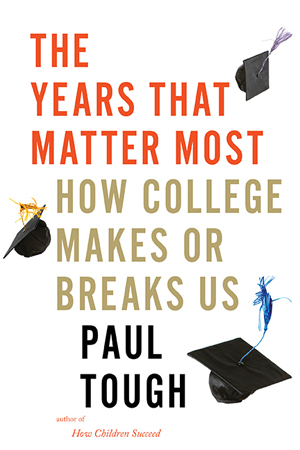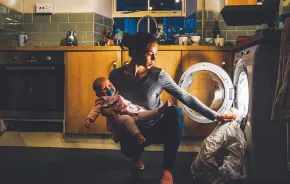
Journalist Paul Tough, best-selling author of “How Children Succeed” and “Helping Children Succeed,” tackles a fundamental question in his latest book, “The Years That Matter Most”: Does college still work?
The price tag of funding a four-year college education has parents across the United States reeling from sticker shock, so Tough is certainly not alone in his consideration of the ultimate return on investment in attending college. It’s a conundrum that weighs heavily on the minds (and pocketbooks) of families from all economic backgrounds.
But underlying Tough’s interest in exploring the current landscape of higher education in America is a preoccupation that has fueled six years of reporting, encompassing visits to 21 U.S. states and interviews with hundreds of students, educators, administrators, nonprofit leaders and experts: the questions of whether our system of higher education is fair and whether it can promise and provide real opportunity to young people seeking to improve their lot in life.
Tough acknowledges that the topic of social mobility is one that has tugged at him throughout his career as a journalist. In this latest book, he concludes — and research reflecting decades of data detailed between its covers confirms it — that opportunity in the United States today depends, in large part, on what happens to individuals during a relatively brief period in late adolescence and early adulthood. The decisions that are made during these “years that matter most” play a critical role in determining the course of the rest of one’s life.
We caught up with Tough to learn more about this latest chapter in his continuing focus on how our children succeed.
How do you contrast your understanding of the current landscape of American higher education with your own college experience in Canada?
My own college experience is ironically choppy. I dropped out of college twice and never went back and got a B.A. I’ve now spent the last six years reporting this book, spending time on college campuses, and I feel a little like it is me catching up from the college days that I missed 30 years ago.
One of the things that I really concluded from my reporting is that a college degree is really valuable and important. I like the notion that students can succeed without college degrees, but I think the reality is that happens very rarely. I did [succeed without one], but who knows how my life would be different if I’d finished my college degree. I don’t feel like I can extrapolate from that experience and say that a college degree isn’t worth anything, that nobody really has to graduate. All the data point in the opposite direction — that degrees matter a whole lot in terms of how young people do.
Your books explore the intersection of education, politics and equity. What experiences, personal or professional, have compelled you to explore these topics?
I would say two things. One, certainly, is the experience of being a father. I have two kids now — two boys, one 10, one 4. Especially with “How Children Succeed” and “Helping Children Succeed,” my last two books, that reporting was about early childhood and about schools. Reading these papers about economics and neuroscience, and the theory and the science behind child development, and then watching the two of them grow up at the same time, [my work] felt very much in sync.
With this new book, I feel like the connection is a little bit more theoretical. What I really care about as a journalist right now — what I care about as a reporter and arguably as a person living in this country — is this concept of social mobility and how young people are able to reach a different kind of adulthood than the experience they grew up in. How kids can rise about the status of their birth. I think that’s just an essential part of a healthy country. I feel like what drew me towards writing about higher education was the evidence, coming from the data and economics, that this is how social mobility works when it works. It happens now through higher education.
Do you concur with the statement “Apply to the most selective college that will admit you and go there”?
One of the things that’s so remarkable to me is the research of a brilliant economist named Caroline Hoxby. She uncovered research from the last 40 or 50 years that examines the minds of a lot of young Americans, especially affluent young Americans. Whereas 40 years ago students made their college decisions based on a wide array of different criteria, now that is the one question that every student seems to be asking: “Where is the most selective college that I can get into? … That’s where I’m going to go.”
What’s even more odd about that, and what can especially lead to some sort of cognitive dissonance for young people, is that on the surface, everyone tells [students] the opposite. There are no books out there that recommend, “Go to the most selective college that will admit you.” There are plenty of books saying, “Just be yourself and your college choice doesn’t matter; you can get a great education at lots of different places.”
It’s hard to find a message that really works. That’s why I feel like the real answer is to reform the whole system. Not to think of it just as a consumer, where we’re trying to get the most for ourselves and our kids, but to look at it as citizens and to [ask] how can we create a more balanced system where social mobility is not this luxury good that affluent parents try to purchase for their kids, but instead where it’s something that we think about collectively; that higher education really benefits a community rather than just an individual kid or family.
How do you assess the influence of the Best Colleges annual index that appears in U.S. News & World Report?
When I talked to admissions people — and I quote this statistic in my book — 97 percent of them said that they can’t stand the U.S. News list, and they think it makes their job harder. It makes them make bad decisions. But I think most of us have the desire to rank things and quantify things and compare things, and if the U.S. News list didn’t exist, someone else would invent it very quickly.
There’s this kind of ecosystem [that exists] where parents and admissions people and U.S. News and the College Board all together have created this system where we assign numbers to students and to colleges. Those numbers tend to correlate really highly with family income. We all make a lot of decisions based on those numbers, and that has created this effect that has become really toxic — certainly for individual students and their families — but more important, it’s toxic for the health of the nation, for the process of social mobility and opportunity in general.
Parents and students feel like it’s oppressive. Absolutely, colleges feel like it’s oppressive, but no one can quite figure out how to turn this machine off.
Can you explain what the term “CFO Specials” refers to?
A “CFO Special” is a tongue-in-cheek word that Jon Boeckenstedt, an admissions director I interviewed for the book, came up with.
As I spent time with Jon and with a lot of other admissions people, I came to understand that so many of their decisions are made by necessity, not based on merit or equity or anything else. They’re based on tuition. These folks are responsible for bringing in lots of tuition in order to keep their colleges afloat. This is not necessarily true at the very most selective colleges, but is true at many of the highly selective colleges. The way to do that is to admit students who can pay full tuition.
What Jon helped me understand, and what other economists have demonstrated in their research as well, is that over the last 20 or 30 years, the big boom in college admissions has been among affluent students who aren’t that good in school. High-scoring affluent kids were always going to college. Now, the kids who have increased their college-going the most over the last couple of decades are students who have low academic achievement but high family incomes. Those are the CFO Specials, and Jon came up with that phrase because those are the ones who make the chief financial officer [at the college or university], the people who are trying to balance the books at these colleges, happy, because [those students] will accept your offer of admission and they are likely to pay the full fee.
How did your understanding of the admissions process change during the course of your reporting?
I think I became less idealistic about college admissions. I certainly became more sympathetic to the stress of being an admissions officer. I now consider it to be more of a game than I used to. It’s more about money than I understood before. There’s this image that gets portrayed in the media of colleges — especially highly selective colleges — as being these very diversity-obsessed places that are admitting lots of low-income students, even if they aren’t as qualified as some high-income students, because they want to have a diverse class. I think I believed that in lots of ways.
Really, what struck me from my reporting on admissions is how much the opposite is true: what a disadvantage low-income students are at, and what an advantage well-off kids have in the whole process. Again, so much of that is because, for most colleges, tuition is really the way they stay afloat, and they need to admit as many people as possible who can pay full fee.
I think the other thing that really surprised me is how much financial aid is entwined with admissions. I write in the book about this new field, this very mysterious field called financial aid optimization. These are the math geniuses who run consulting companies that almost every college admissions office consults with.
In the past, admissions and financial aid were very much separate. Admissions would decide who they wanted to admit, and then financial aid would decide who needed how much money to attend. Now, tuition is just much more flexible than it used to be. Colleges do post official tuition rates, but they offer huge discounts on those tuition rates, and they offer very different discounts to different students, not necessarily based on how much those families can afford, or even necessarily based on how qualified those students are. [It’s] based on this complex algorithm of how much the college is worth to the student and how much the student is worth to the college.
There’s someone sitting at a computer screen somewhere, not even at the university, but at this consulting place, calculating exactly what it will take to get you or your student to attend this college, and how much they think you’re willing to pay. That’s a little scary.
What do you think needs to change fundamentally in the admissions profession to help universities start to “do the right thing” with respect to equitable enrollment?
I tend to think that there are maybe three different changes that would make things better and fairer. With those very most selective institutions — I’m talking about maybe the 10 or 20 most selective institutions in the country, which also happen to be the 10 or 20 richest institutions in the country — they really can unilaterally decide to have more equity in their admissions. Their model of how they stay afloat economically is that they might seem like they charge lots in tuition, but in reality they’re spending much more money than they take in on each student, and their bet is that when those excellent students grow up and make a lot of money, they’ll give a lot back. They could make that bet on low-income students just as easily as high-income students. If you’re a low-income student and you go to Harvard or Princeton and you get rich, you are more likely than anybody to give back to your institution.
Second, for more middle-tier institutions, I think changing the emphasis that’s put on the SAT and the ACT would make a big difference. I don’t think necessarily every institution needs to go test-optional, but the colleges I studied that did go test-optional, it gave them at least a bit of an extra ability to break out of that trap … to consider other students who would be a great addition to any campus but whose test scores don’t seem high enough to justify it. I think that’s a change that individual institutions can make.
Private institutions are private institutions, and they can do whatever they want. There are lots of ways that they could do better, but they have the right to make their decisions however they want. Public institutions, however, work for us and we fund them. The fact that they have changed as drastically as they have over the past 10 or 20 years is, to my mind, much more important and distressing. It’s something that we can actually affect, because we elect the people who make the decisions about these institutions and we pay the taxes that keep these institutions afloat.
The reality is, we’re not spending enough on those institutions. Most states have cut their higher education budget over the last 10 or 20 years, at a moment when every sign in the economy is that we need more highly educated young people, and we need to find more options for those young people to get those credentials that they need without [incurring] crushing amounts of debt. The way to do that is to fund higher education publicly. That’s what the United States has always done. That’s what most countries in the world do, and that’s what we’ve stopped doing.
After all your reporting for the book, what is your balance of hope versus cynicism when it comes to the potential of youths to attain greater social mobility through higher ed?
It depends on the day. I feel like objectively, empirically, it is easy to be pessimistic. Most indicators in terms of equity in higher education are not only not very good, they’re also heading in the wrong direction. At this moment where we now understand better than we did how unequal higher education is, it’s not like we’re responding to it by making things fairer in general. Things are continuing to become less fair. That’s kind of depressing.
But I am essentially an optimistic person. So many of the people who work in the system are really good, idealistic, altruistic, hopeful people. With very few exceptions, they want the system to be better and fairer. They mostly just feel trapped by the system and unable to make changes. I tend to feel like when everyone feels that way, and when they’re able to find ways to communicate that fact, that things can change pretty easily and pretty effectively.
My hope is that my book, in putting all this research together in one place, will be a part of that process. That it will help people look a little more universally at the system and understand how they fit into it, instead of just trying to maximize things for themselves — for my college, my kid, my job, or how I am going to maximize the prospects for that one part of the system that I am connected to — and instead take a look at higher education more collectively, more generally as citizens. I think if we do that, we’ll make very different decisions about how to make the system work more equitably for all.











